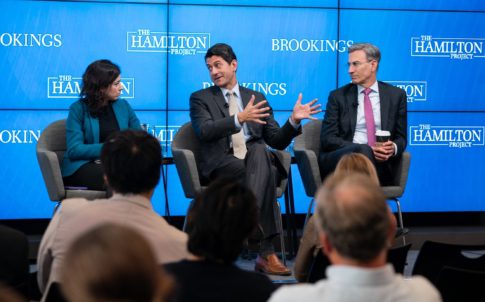The chance to greatly reform tax policy in the United States approaches rapidly. Almost all provisions of the Tax Cuts and Jobs Act (TCJA), including individual, estate, and pass-through provisions, are set to expire at the end of 2025, setting the scene for a large tax debate. In 2025, leaders will have the opportunity to pass sweeping tax reform and potentially create a more efficient, equitable, and fiscally stable tax system. The Hamilton Project at Brookings convened experts on Wednesday, September 27, 2023 to discuss this momentous opportunity.
The event, which consisted of opening remarks from former U.S. Treasury Secretary Robert E. Rubin and three panels featuring various tax policy experts, propelled rigorous discussion on a variety of tax reform topics. The event coincided with the release of a wide-ranging tax reform proposal, by Kim Clausing (University of California, Los Angeles) and Natasha Sarin (Yale University), that would raise significant revenue, improve progressivity, and better align the U.S. with global tax policy. In addition, The Hamilton Project released an essay offering principles for assessing proposed reforms.
Rubin began his remarks by painting a picture of the troubling reality of the American fiscal horizon, stating, “This is an unsustainable fiscal trajectory. It is going to create terrible problems in respect to interest rates, inflation, and the availability of funds for public investment.” He added that the next two years provide “an opportunity to improve tax policy and to improve rapidly increasing debt to GDP ratio, but the politics and the substance are very difficult.”
Following Rubin, Peter Orszag (former director of the Office of Management and Budget and currently of Lazard Freres & Co LLC) and former Speaker of the U.S. House of Representatives Paul Ryan took to the stage for the first panel, moderated by Catherine Rampell of The Washington Post.
After discussing how the U.S. arrived a this particular policy moment, the panelists transitioned to discussing the viability of tax reform in the coming years. Ryan stated that he believes under a divided government—which he predicts will continue into 2025—not much stands to change. While he expects there to be large debates regarding base-broadening and the Child Tax Credit (CTC), he sees the most realistic change being a shift back to the Obama-era top marginal tax rate, a shift back up to 39.6 percent from 37 percent. Orszag, on the other hand, emphasized the amount of opportunity that can still come from a “small” shift in the top marginal tax rate. He expressed that, “At the margin it makes revenue increases that are embedded in current law more likely, and at the margin it makes new stuff less likely because anything that requires action is just hard.” Although both Ryan and Orszag spoke to the difficulty of the passing large reforms, the panel ended with both expressing their optimism for a carbon border tax and returning the CTC to its pandemic-era state that widely reduced child poverty in the United States.
The second panel of the event was a conversation moderated by Wendy Edelberg (The Hamilton Project) with Natasha Sarin. During this panel, Sarin discussed why she and her co-author—Kimberly Clausing—were inspired to start this discussion now. Among her reasons, Sarin emphasized that while a lot has been done to the tax code, there is still much left to do. She and Clausing saw an opportunity to present a pathway to tax reform that would largely benefit the U.S. Notably, she mentioned the variety of low-hanging fruit that could transform the state of our fiscal system. She stated, “There are real spending needs that this country faces that we should be able to devote revenues to.” One example Sarin included of low-hanging fruit that could be greatly impactful is the simple and continual funding of the IRS, which she stated would allow the agency to close a large revenue gap by allowing it to actually collect the taxes it is owed and allow it to increase its efficiency and functionality for the American people.
“There are real spending needs that this country faces that we should be able to devote revenues to.”
– Natasha Sarin
The last panel of the event was moderated by Ben Harris (The Brookings Institution) and featured panelists Clausing, Kyle Pomerleau (American Enterprise Institute), and Nirupama Rao (The University of Michigan). Clausing began the panel by reiterating the four principles of the proposal and their vision for the extension of the TCJA in 2025. She highlighted that their proposal focuses on a revenue neutral version of the extension as opposed to a revenue-losing version. Pomerleau joined the conversation by saying that the largest difference if these reforms were enacted would be how revenue is dealt with. In the Clausing/Sarin proposal revenue neutrality would be achieved through individual provisions, such as base broadening itemized deduction provisions and using that to slim down the alternative minimum tax. Alternatively, Pomerleau stated that without these reforms we would see full extension of the individual provisions of the TCJA, which would “lose a boatload of revenue each and every year.”
The last question of the day was posed by Harris, who asked, “What is the most important provision that you’d like to see either preserved from the TCJA or introduced in 2026 when we take a fresh look at this?” Without hesitation, Rao responded that she would choose to restore the CTC to its previously broad and refundable state that greatly reduced child poverty. She expressed that she believes the previous expansion of the CTC was one of the biggest policy accomplishments in the last decade, and she “would like to believe we live in a country that wouldn’t stand for that disappearing.”
The event concluded with the panelists in agreement that one of the most significant political compromises Congress stands to make in 2025 is the reform of international business taxation. Clausing, Pomerleau, and Rao all nodded in agreement that the U.S. lags behind its international partners on the taxation of multinational corporations, missing out on large swaths of revenue each year.
This is a summary of “Taking on tax: The past, present and future.“




